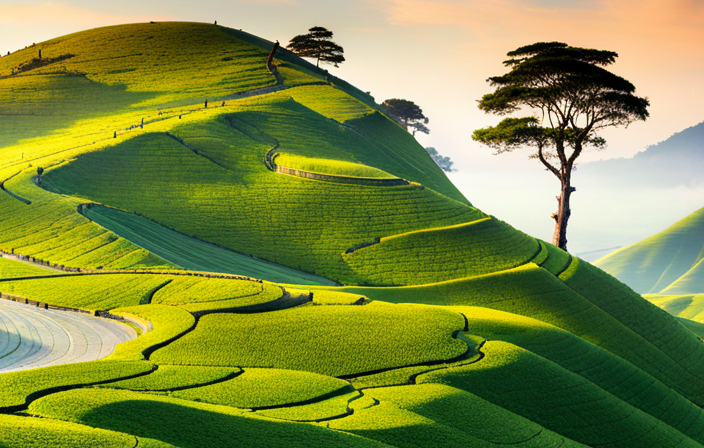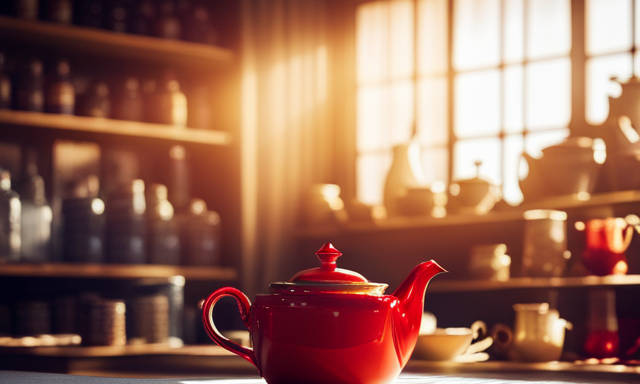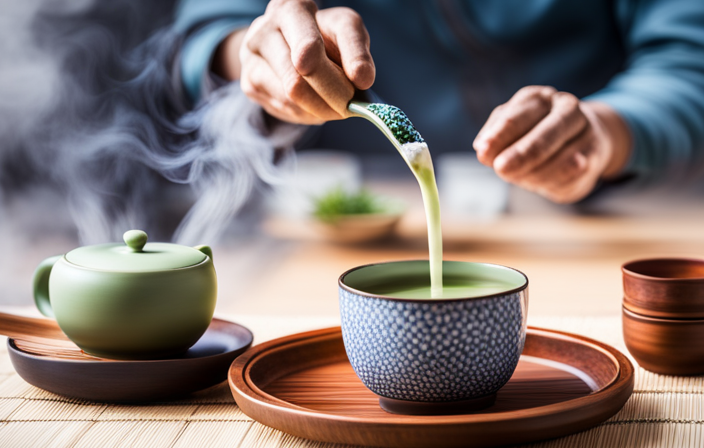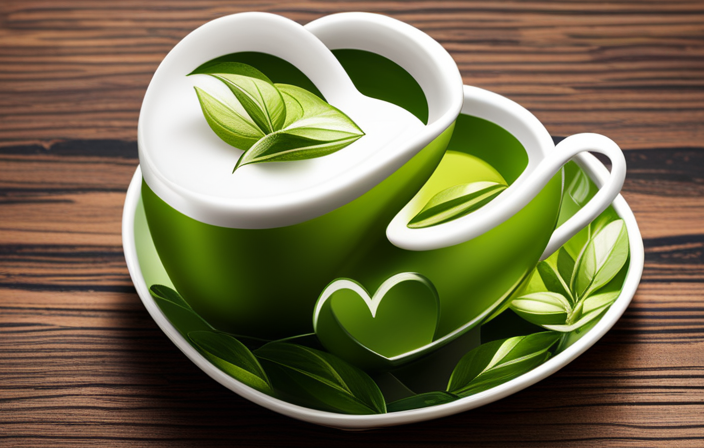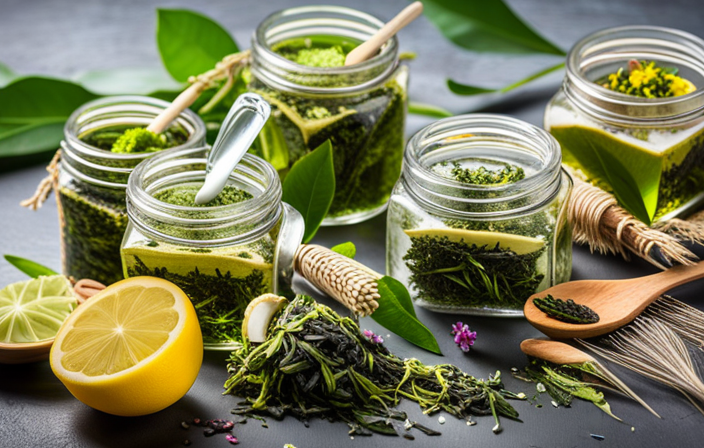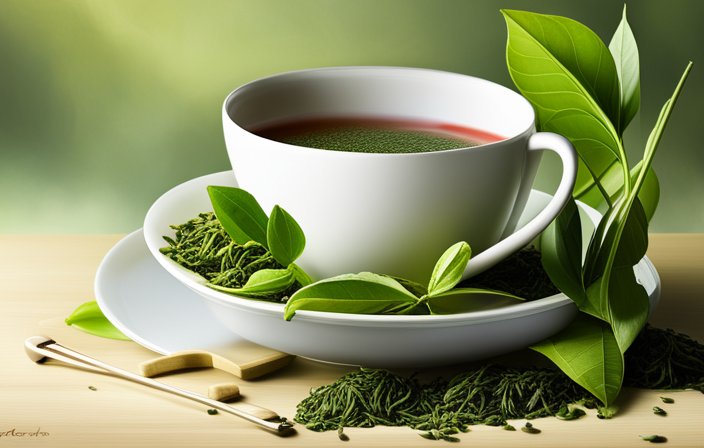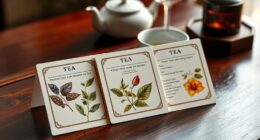Welcome to the fascinating world of green tea varieties! Join me as we embark on a journey of discovery, exploring the infinite flavors and aromas that these teas have to offer.
From delicate and floral to robust and earthy, each sip will transport you to a realm of pure pleasure. With my expertise as your guide, we will delve into the art of brewing and unravel the distinct characteristics of different green tea varieties.
Get ready to indulge your senses and expand your tea-loving horizons!
Key Takeaways
- Green tea varieties originate from different countries, including Japan, China, India, Korea, and Sri Lanka.
- Green tea is processed using various techniques such as steaming, pan-firing, grinding into powder, shade-grown, and combination with roasted brown rice.
- Each green tea variety has its own unique flavor profile, ranging from fresh and grassy to earthy and rich, and from umami and sweet to nutty and toasty.
- Green tea offers numerous health benefits, including antioxidant properties, weight loss, improved brain function, and cultural significance in tea ceremonies and rituals.
Understanding the Basics of Green Tea Varieties
I really enjoy trying different types of green tea varieties and understanding their unique flavors. Green tea has a rich history and originates from various regions around the world. Each region’s climate, soil, and altitude contribute to the distinct characteristics of the tea.
For example, Japanese green teas are known for their vibrant green color and umami flavor, while Chinese green teas offer a wide range of flavors from nutty to floral. The processing methods also play a significant role in the flavor profiles. Some teas are steamed, like Japanese sencha, while others are pan-fired, like Chinese Dragonwell.
Exploring the origins and processing methods of green tea allows me to appreciate the intricate details and complexities of each variety.
Transitioning into the next section, let’s now delve into the fascinating world of exploring a wide range of green tea varieties.
Exploring a Wide Range of Green Tea Varieties
As a tea enthusiast, I’m constantly amazed by the vast array of green tea varieties available. From delicate and floral to robust and earthy, each tea offers a unique flavor profile that can transport you to different parts of the world.
Beyond the delicious taste, green tea is also known for its numerous health benefits, making it a truly remarkable beverage.
Health Benefits of Green Tea
Have you ever wondered what specific health benefits green tea provides? Well, let me enlighten you.
Green tea is a powerhouse of health benefits, particularly when it comes to weight loss and its antioxidant properties. When it comes to shedding those extra pounds, green tea is your ally. Its natural compounds help boost metabolism and fat oxidation, aiding in weight loss.
But that’s not all. Green tea is also packed with antioxidants, which help protect our cells from damage caused by harmful free radicals. These antioxidants promote overall well-being and can reduce the risk of chronic diseases.
Flavor Profiles of Varieties
Exploring the flavor profiles of different green tea varieties is a delightful journey of discovering unique tastes and aromas. Each variety offers a distinct experience, transporting you to the lush tea gardens where these leaves are grown and harvested. From the grassy notes of sencha to the delicate floral undertones of jasmine green tea, each sip is a sensory delight that captivates the palate.
Pairing green tea with food adds another layer of enjoyment to this experience. The earthy notes of matcha complement the richness of dark chocolate, while the nutty flavors of genmaicha enhance the umami of sushi. The possibilities are endless, and the art of pairing allows you to create harmonious culinary experiences.
Now, let’s delve into the next phase of this journey: brewing techniques for perfection.
Brewing Techniques for Perfection
I can’t wait to experiment with different brewing techniques to achieve the perfect cup of green tea. As someone who is passionate about serving others, I believe that the art of brewing tea goes beyond just the ingredients. It involves the right brewing equipment and an understanding of the traditional tea ceremonies. To enhance my knowledge and skills, I have created a table below showcasing three popular brewing techniques:
| Technique | Equipment Needed | Description |
|---|---|---|
| Japanese Method | Kyusu teapot, Kyusu cups | Involves steeping green tea leaves in a kyusu teapot and serving it in kyusu cups for a traditional Japanese experience. |
| Gongfu Method | Yixing teapot, Gongfu tea set | Utilizes a Yixing teapot and a Gongfu tea set to brew tea in small, concentrated amounts for a strong and flavorful taste. |
| Western Method | Teapot, teacups, tea infuser | Uses a regular teapot with a tea infuser to brew larger quantities of green tea suitable for Western preferences. |
Comparing the Unique Tastes of Green Tea Varieties
There are several green tea varieties, each offering a distinct taste profile. Comparing flavor profiles and exploring the health benefits of these teas is an exciting journey that I’m eager to embark on. From delicate and grassy Sencha to the floral and nutty notes of Jasmine Green Tea, the world of green tea is a treasure trove of flavors waiting to be discovered.
Not only do these teas offer a delightful taste experience, but they also come with numerous health benefits. Rich in antioxidants, green tea can boost metabolism, improve brain function, and even reduce the risk of heart disease. Each variety brings its own unique set of health benefits, making it a truly holistic beverage choice.
Now that we’ve explored the flavor profiles and health benefits of green tea varieties, let’s dive into the next exciting chapter: mastering the art of brewing these teas to perfection.
Mastering the Art of Brewing Green Tea Varieties
When it comes to brewing green tea varieties, mastering the art is essential to unlock their full potential. The key lies in understanding the optimal brewing temperatures, steeping time recommendations, and tea-to-water ratio tips.
Each variety has its own unique characteristics that can be enhanced or diminished by the brewing process, so it’s crucial to pay attention to these details and brew with precision and care.
Optimal Brewing Temperatures
During my research, I discovered that different green tea varieties require specific optimal brewing temperatures for the best flavor and aroma. Understanding these temperatures is crucial in order to fully appreciate the nuances and subtleties of each tea.
Here are three key points to consider:
-
Brewing Equipment: Investing in a good quality kettle with temperature control is essential for achieving the right brewing temperature. This ensures that your green tea is neither under-brewed nor over-brewed, resulting in a perfectly balanced cup.
-
Steeping Methods: The length of time that green tea leaves are steeped also affects the flavor profile. It’s important to follow the recommended steeping times for each variety to avoid bitterness or a weak brew.
-
Temperature Guidelines: While each green tea has its own optimal brewing temperature, a general guideline is to brew delicate teas like sencha and gyokuro at lower temperatures around 160-180°F, while heartier teas like matcha and hojicha can be brewed at higher temperatures around 180-190°F.
Steeping Time Recommendations
I always follow the recommended steeping times for each green tea variety to ensure a perfectly brewed cup of tea. Steeping time variations are crucial in extracting the best flavors and aromas from the leaves.
Each green tea variety has its own unique characteristics that can be enhanced or diminished depending on the steeping time. For delicate teas like sencha or gyokuro, a shorter steeping time of around 1-2 minutes is ideal to prevent bitterness. On the other hand, bolder teas like matcha or genmaicha can handle a longer steeping time of 2-3 minutes without becoming overpowering.
It’s also important to consider the water temperature, as it can affect the extraction process. Using water that’s too hot can result in a bitter or astringent taste, while water that’s too cool may not fully extract the flavors.
Tea-To-Water Ratio Tips
To truly savor the delicate flavors of green tea, it’s essential to master the tea-to-water ratio, ensuring a perfectly balanced brew. Green tea brewing methods can vary, but getting the right ratio is key to unlocking the full potential of this beloved beverage.
Here are some tips to help you achieve the perfect tea-to-water ratio:
-
Start with a ratio of 1 teaspoon of green tea leaves to 8 ounces of water.
-
Adjust the ratio based on personal preference. If you prefer a stronger brew, increase the amount of tea leaves.
-
Experiment with different ratios to find your ideal balance of flavor and strength.
Green tea flavor profiles can range from grassy and vegetal to floral and nutty. By mastering the tea-to-water ratio, you can bring out the best in each variety and create a truly enjoyable tea experience. So grab your teapot and start brewing!
Noting the Distinct Differences Among Green Tea Varieties
Honestly, I can’t help but appreciate the subtle nuances among different green tea varieties. It’s truly fascinating how each type of green tea offers a unique taste and aroma.
When it comes to comparing the antioxidant levels of green tea varieties, it’s important to note that all green teas are rich in antioxidants, but the levels can vary depending on factors such as the region where the tea is grown and the processing methods used.
For those seeking a higher antioxidant content, matcha green tea is a great choice as it’s made from finely ground tea leaves, allowing you to consume the whole leaf and maximize the antioxidant benefits.
Additionally, understanding the different caffeine levels in green tea varieties is crucial for those who are sensitive to caffeine or prefer a milder option. While all green teas contain caffeine, the levels can differ. Sencha green tea, for example, typically has a moderate caffeine content, while Gyokuro green tea has a lower caffeine content due to its shading process.
Uncovering Personal Favorites in the World of Green Tea
When it comes to green tea, there’s a world of flavors waiting to be discovered. Each variety offers a unique flavor profile that can range from grassy and vegetal to floral and sweet.
Along with its delicious taste, green tea is also known for its numerous health benefits, such as boosting metabolism and improving brain function.
To fully appreciate and uncover personal favorites in the world of green tea, it’s important to explore different brewing techniques that bring out the best in each variety.
Unique Flavor Profiles
I’m fascinated by the unique flavor profiles that green tea offers, from its grassy notes to its subtle hints of sweetness. Green tea has a rich history and diverse range of varieties, each with its own distinct characteristics.
Let me take you on a journey through the world of green tea flavors:
-
Matcha: This vibrant green powdered tea has a rich umami flavor and a velvety texture. It’s traditionally prepared by whisking it with hot water until frothy, creating a unique and invigorating experience.
-
Sencha: With its refreshing taste and vegetal notes, sencha is one of the most popular green teas in Japan. It’s brewed using unique brewing methods that enhance its delicate flavors and vibrant green color.
-
Dragon Well: Originating from China, this tea has a mellow and chestnut-like flavor. Its leaves are hand-plucked and pan-fired, giving it a unique toasty aroma.
Exploring the unique brewing methods and historical origins of these green tea varieties adds depth and appreciation to the tea-drinking experience.
Health Benefits Explored
I’ve always been intrigued by the health benefits of green tea, and I’m excited to explore them further.
Green tea has been consumed for centuries and is renowned for its numerous health benefits. Scientific studies have shown that green tea is rich in antioxidants, which help protect the body against free radicals and reduce the risk of chronic diseases. It also contains compounds that can improve brain function, boost metabolism, and aid in weight loss.
Beyond its physical advantages, green tea holds cultural significance in many countries, with unique rituals and ceremonies surrounding its preparation and consumption. These traditions highlight the importance of mindfulness and gratitude, creating a sense of calm and tranquility.
As I delve deeper into the world of green tea, I’m eager to discover the secrets behind its health-promoting properties and uncover the cultural significance and rituals that make it a cherished beverage.
Best Brewing Techniques
Lately, I frequently experiment with different brewing techniques to find the best way to bring out the flavors of my favorite green tea varieties. As a tea enthusiast, I believe that the brewing process is just as important as the tea itself.
Here are three essential factors to consider when brewing green tea:
-
Brewing equipment: Investing in high-quality teapots and infusers can greatly enhance your tea experience. The right equipment ensures that the tea leaves are steeped evenly, allowing the flavors to fully develop.
-
Water temperature: Green tea is delicate and requires a lower water temperature compared to other teas. Finding the perfect balance between heat and steeping time is crucial to avoid bitterness and achieve a smooth, refreshing taste.
-
Tea ceremony: Embracing the art of the tea ceremony can elevate your brewing technique. Taking the time to perform each step with mindfulness and grace, from measuring the tea leaves to pouring the tea into cups, adds a sense of tranquility and intention to the process.
Immersing Yourself in the Rich Tea Culture Surrounding Green Tea Varieties
As a tea enthusiast, I love delving into the rich tea culture surrounding green tea varieties and immersing myself in the myriad of flavors and traditions they offer. Green tea has a long-standing history and cultural significance, deeply rooted in Asian countries like China, Japan, and Korea. Let me take you on a journey through the enchanting world of green tea traditions.
In China, green tea is often associated with health and wellness. It’s commonly consumed during meals or as a form of hospitality. The delicate aroma and mellow taste of Chinese green teas, such as Longjing and Bi Luo Chun, captivate the senses and leave a lasting impression.
In Japan, the tea ceremony, known as Chanoyu, is a cherished cultural practice that embraces mindfulness and harmony. Matcha, a powdered green tea, takes center stage in this ritual, symbolizing purity and tranquility. The preparation and presentation of Matcha is an art form in itself, with every step carefully executed to create a serene experience.
In Korea, green tea is a symbol of hospitality and respect. The traditional Korean tea ceremony, called Darye, is a formal affair where guests are served Korean green teas like Sejak and Jeoncha. The serene atmosphere and graceful movements during the ceremony reflect the deep appreciation for nature and the importance of connection.
By examining the green tea traditions from different cultures, we gain insights into their values and ways of life. Sharing knowledge and insights about green tea varieties allows us to appreciate the beauty and diversity of this beloved beverage.
Sharing Knowledge and Insights About Green Tea Varieties
Fortunately, we can now share our knowledge and insights about green tea varieties, as there are countless resources available online and in books. Exploring green tea origins is like embarking on a journey around the world, discovering the diverse landscapes where this beloved beverage is cultivated.
From the lush tea gardens of Japan to the misty mountains of China, each region brings its unique flavor profile and aroma to the table. Understanding green tea processing techniques is equally fascinating. From the delicate steaming process of Japanese Sencha to the pan-firing method used in Chinese Dragonwell, each step contributes to the final product’s taste and appearance.
It’s incredible how the leaves transform from their raw state to the vibrant green brew we enjoy. Through sharing our knowledge, we can inspire others to appreciate the artistry behind every sip and encourage exploration of the vast world of green tea varieties.
Expanding Your Tasting Experience With Green Tea Varieties
I can’t wait to try new green tea varieties and expand my tasting experience with different flavors and aromas. As a tea lover, exploring the world of green tea is an exciting journey of discovery. The diverse range of green tea alternatives offers a multitude of options for tea selection. From delicate and grassy Sencha to the bold and nutty Genmaicha, each variety has its own unique characteristics that can tantalize your taste buds. To help you navigate this vast world, here is a table showcasing four popular green tea varieties:
| Green Tea Variety | Flavor Profile | Aroma |
|---|---|---|
| Sencha | Fresh, grassy | Vegetal |
| Matcha | Earthy, rich | Vegetal |
| Gyokuro | Umami, sweet | Vegetal |
| Genmaicha | Nutty, toasty | Roasted |
Continuing Your Journey of Learning About Green Tea Varieties
To deepen my understanding of green tea varieties, I’ll research different brewing methods and experiment with various steeping times. Mastering the art of green tea brewing requires a combination of knowledge, technique, and passion. As I embark on this journey, I’m excited to explore the world of rare and exotic green tea varieties.
Here are some of the fascinating aspects I’ll be delving into:
- Uncovering the secrets behind the delicate and fragrant Matcha tea, known for its vibrant green color and health benefits.
- Discovering the unique taste profiles of Gyokuro, a shade-grown tea with a sweet and savory flavor.
- Exploring the ancient Chinese tradition of Longjing tea, with its smooth, nutty taste and delicate aroma.
Frequently Asked Questions
How Many Different Types of Green Tea Varieties Are There?
There are various types of green tea varieties with different flavors and benefits. It’s fascinating to explore the world of green tea and discover the unique characteristics that each variety brings.
What Is the Best Brewing Method for Green Tea?
The best time to drink green tea depends on personal preference, but I find that a cup in the morning or afternoon is invigorating. With its different flavors, green tea offers a delightful and refreshing experience.
Are There Any Health Benefits Associated With Drinking Green Tea?
Drinking green tea has numerous health benefits. It aids in weight loss by boosting metabolism and has anti-inflammatory properties that reduce inflammation in the body. It’s a powerful beverage that promotes overall well-being.
Can Green Tea Be Used for Cooking or Baking?
Yes, green tea can be used for cooking or baking. It adds a unique flavor and subtle bitterness to dishes. Get creative with green tea recipes like matcha-infused desserts or savory dishes with green tea marinades.
What Are Some Common Misconceptions About Green Tea?
Some misconceptions about green tea include its low nutritional value and high caffeine content. However, green tea is actually packed with antioxidants and has less caffeine than coffee. Let me enlighten you!
Conclusion
As I continue to explore the world of green tea varieties, I’m amazed by the vast array of flavors and aromas waiting to be discovered.
The distinct differences among these teas offer a truly immersive and enriching experience. From the delicate and grassy taste of Sencha to the bold and earthy notes of Matcha, each variety offers a unique journey for the senses.
With every sip, I’m captivated by the rich tea culture and the endless possibilities for expanding my tasting experience.

